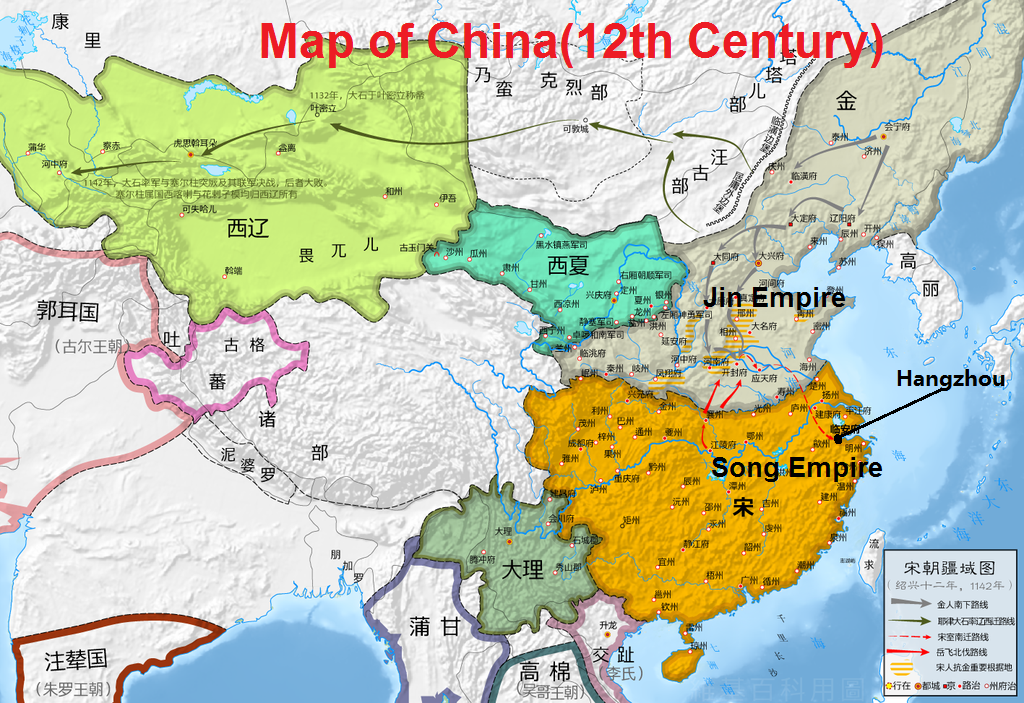- 04 Feb 2017 14:47
#14771890
Actually it was a series of alliances followed by war followed by peace and so on until the Mongols arrived.
The Song remained a nation until 1279 after the Jin had already fallen.
The Ming dynasty was of Mongol origin that united both the northern dynasties and southern dynasties for the first time.
Thats when China as a united empire that acted as the foundation of what modern China was born.
Thus as said, both northern and southern people whom are Jurchens and the hans are what we now know as Chinese people.
The removal of the Ming and establishment of the Qing sure was a bloody change, but it was internal, not external. Which is the point 'm arguing about. Saying as in the OP that the Jurchen conquered and enslaved Chinese people is simply a false statement.
Both the Jurchen and the Han are what we know now as Chinese.
https://en.wikipedia.org/wiki/Manchuria ... _and_names
Ok, it seems that the name does indeed originate from that older name.
Not impressed ? Is impressing you a requirement ?
But since we're talking about research here. You might want to check the map of the Jin dynasty because this is how it was at the end

They were united then by the mongols and thus China became a thing.
The Song remained a nation until 1279 after the Jin had already fallen.
The Ming dynasty was of Mongol origin that united both the northern dynasties and southern dynasties for the first time.
Thats when China as a united empire that acted as the foundation of what modern China was born.
Thus as said, both northern and southern people whom are Jurchens and the hans are what we now know as Chinese people.
The removal of the Ming and establishment of the Qing sure was a bloody change, but it was internal, not external. Which is the point 'm arguing about. Saying as in the OP that the Jurchen conquered and enslaved Chinese people is simply a false statement.
Both the Jurchen and the Han are what we know now as Chinese.
"Manchuria" is a translation of the Japanese word Manshū, which dates from the 19th century. The name Manju (Manzhou) was invented and given to the Jurchen people by Hong Taiji in 1635 as a new name for their ethnic group; however, the name "Manchuria" was never used by the Manchus or the Qing dynasty itself to refer to their homeland. According to the Japanese scholar Junko Miyawaki-Okada, the Japanese geographer Takahashi Kageyasu was the first to use the term "満州" (Manshū) as a place name in 1809 in the Nippon Henkai Ryakuzu, and it was from that work that Westerners adopted the name.According to Mark C. Elliott, Katsuragawa Hoshū's 1794 work, the "Hokusa bunryaku", was where "満州" (Manshū) first appeared as a place name was in two maps included in the work, "Ashia zenzu" and "Chikyū hankyū sōzu" which were also created by Katsuragawa. "満州" (Manshū) then began to appear as a place names in more maps created by Japanese like Kondi Jūzō, Takahashi Kageyasu, Baba Sadayoshi and Yamada Ren, and these maps were brought to Europe by the Dutch Philipp von Siebold. According to Nakami Tatsuo, Philip Franz von Siebold was the one who brought the usage of the term Manchuria to Europeans after borrowing it from the Japanese, who were the first to use it in a geographic manner in the eighteenth century although neither the Manchu nor Chinese languages had a term in their own language equivalent to "Manchuria" as a geographic place name. The Manchu and Chinese languages had no such word as "Manchuria" and the word has imperialist connotations. According to Bill Sewell, it was Europeans who first started using the name Manchuria to refer to the location and it is "not a genuine geographic term". The historian Gavan McCormack agreed with Robert H. G. Lee's statement that "The term Manchuria or Man-chou is a modern creation used mainly by westerners and Japanese", with McCormack writing that the term Manchuria is imperialistic in nature and has no "precise meaning" since the Japanese deliberately promoted the use of "Manchuria" as a geographic name to promote its separation from China at the time they were setting up their puppet state of Manchukuo.The Japanese had their own motive for deliberately spreading the usage of the term Manchuria. The historian Norman Smith wrote that "The term 'Manchuria' is controversial".Professor Mariko Asano Tamanoi said that she "should use the term in quotation marks" when referring to Manchuria. In his 2012 dissertation on the Jurchen people to obtain a Doctor of Philosophy degree in History from the University of Washington, Professor Chad D. Garcia noted that usage of the term "Manchuria" is out of favor in "current scholarly practice" and that he had ceased using the term, instead using "the northeast" or referring to specific geographical features.
https://en.wikipedia.org/wiki/Manchuria ... _and_names
Ok, it seems that the name does indeed originate from that older name.
Not impressed ? Is impressing you a requirement ?
But since we're talking about research here. You might want to check the map of the Jin dynasty because this is how it was at the end

They were united then by the mongols and thus China became a thing.
Last edited by anasawad on 04 Feb 2017 14:52, edited 1 time in total.
Vive la révolution










 ). But he doesn't care about historical accuracy. I think he doesn't even read Chinese. He is just part of that human debris left by the British empire strewn across the globe. Dismissed from the navy not very honorably, he tries to make a living by whatever means. But in that he is typical of travel writers including Marco Polo, Fernao Mendes Pinto, etc., they all mix the occasional fact with a liberal doses of fantasy. They can be seen in the tradition of Don Quixote.
). But he doesn't care about historical accuracy. I think he doesn't even read Chinese. He is just part of that human debris left by the British empire strewn across the globe. Dismissed from the navy not very honorably, he tries to make a living by whatever means. But in that he is typical of travel writers including Marco Polo, Fernao Mendes Pinto, etc., they all mix the occasional fact with a liberal doses of fantasy. They can be seen in the tradition of Don Quixote. 

 - By Tainari88
- By Tainari88 - By JohnRawls
- By JohnRawls